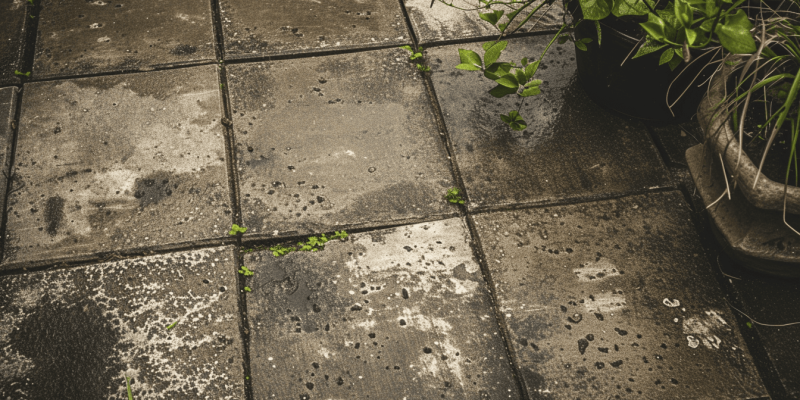Springfield’s homes often feature concrete patios, valued for their durability and aesthetic appeal. However, their very construction makes them prone to staining. Concrete is a porous material, composed of water, sand, gravel, and cement. Like a sponge, it absorbs liquids and other materials that come into contact with it. This porosity is the primary reason why stains can be such a persistent problem.
Common Types of Stains and Their Causes
- Oil Stains: Oil stains on concrete patios often originate from vehicles, barbeque spills, or machinery leaks. These stains are notorious for penetrating deep into the concrete, resulting in dark, slick spots that mar the surface. The primary challenge with oil stains lies in their stubborn nature, as they are resistant to regular cleaning methods. This resistance necessitates a more targeted approach for effective removal.
- Rust Stains: Rust stains typically appear from metal patio furniture, tools, or fixtures that have been left exposed to the elements. These stains are easily recognizable by their distinctive reddish-brown discoloration, which can dramatically alter the appearance of your concrete surface. The difficulty with rust stains is that they can be deeply embedded within the concrete, making them a challenge to remove without the right cleaning products and techniques.
- Organic Stains: Organic stains are commonly due to leaves, moss, berries, and other natural elements, particularly in areas that are shaded or retain moisture. Such stains usually leave a greenish or brownish tint on the concrete and can spread over large areas if not addressed promptly. The main challenge with organic stains is that they can lead to more persistent staining and even surface damage over time, underscoring the importance of timely intervention.
- Paint Stains: Paint stains on concrete patios often result from accidental spills during painting projects or artistic activities. These stains, especially when involving oil-based paints, can adhere strongly to concrete surfaces, making them difficult to remove. The challenge with paint stains is that they require specific solvents to effectively break down the paint, all while ensuring the concrete itself is not harmed.
NOTE
Each type of stain has its unique characteristics and requires a tailored approach for effective removal. Understanding these nuances is crucial in choosing the most effective cleaning methods to restore your patio’s appearance.
Step-by-Step Stain Removal Guide
Removing Oil Stains
- Initial Cleaning: Begin the oil stain removal process by absorbing as much oil as possible. This can be effectively done using rags, paper towels, or absorbent materials like cat litter or sawdust. Generously cover the stain with the absorbent material and allow it to sit for several hours, or even overnight, to soak up the oil. Once the oil is absorbed, sweep or vacuum the material away.
- Detergent Application: After the initial absorption, apply a grease-cutting detergent directly to the stained area. Household dish soap or laundry detergent can be effective. Scrub the area gently with a stiff brush or broom, working the detergent into the stain. Allow the detergent to sit for 15-30 minutes to break down the oil, then rinse the area with hot water. Repeat this process if the stain persists, as multiple applications may be necessary for older or deeper stains.
- Degreaser Use: For more stubborn or older oil stains, a commercial degreaser may be required. These products are specifically designed to break down and lift oil from concrete surfaces. Follow the manufacturer’s instructions carefully, applying the degreaser to the stain and allowing it to sit for the specified amount of time. Afterward, scrub the area with a brush to help lift the stain, and then rinse thoroughly with water. Always wear gloves and protective eyewear when working with chemical degreasers.
Eliminating Rust Stains
- Commercial Rust Remover: For rust stains, commercial rust removers are an effective solution. These products often contain oxalic acid or phosphoric acid, which react with the rust to dissolve it. Apply the rust remover directly to the stain as per the product instructions. Allow it to sit and penetrate the stain for the time recommended by the manufacturer, then scrub the area with a stiff brush. Rinse the area thoroughly with water after scrubbing.
- Natural Solution: A more natural approach to rust stain removal involves creating a paste using lemon juice and salt. The acidity of the lemon juice helps to break down the rust, while the salt acts as a mild abrasive. Cover the rust stain with this paste and let it sit for several hours or as long as overnight. Afterward, scrub the area with a brush to remove the rust, and rinse the area well with water.
Organic Stain Removal
- Regular Cleaning: Prevent organic stains such as leaves, moss, and mildew by regularly sweeping your patio. Removing natural debris before it has a chance to decompose and stain the concrete is a key preventative measure.
- Mild Detergent Solution: To remove existing organic stains, use a mild detergent solution. Mix water with a mild dish soap or a specially formulated concrete cleaner. Apply this solution to the stained area and scrub with a brush. This method is particularly effective for mildew or moss. Rinse the area thoroughly with water after scrubbing.
Paint Stain Solutions
Paint Stripper Application: For paint stains, especially those that are dried and set, a paint stripper designed for use on concrete may be necessary. Carefully follow the instructions on the product, applying it to the affected area. Allow the stripper to sit for the time specified by the manufacturer to soften the paint.
Rinse and Repeat: After the paint has softened, use a scraper or brush to gently remove the paint. Be careful not to scratch or damage the concrete surface. Once the bulk of the paint is removed, rinse the area thoroughly with water. If traces of paint still remain, a second application of the paint stripper may be necessary. Always wear appropriate safety gear, such as gloves and goggles, when handling chemical strippers.
NOTE
When using chemicals, always wear protective gear and ensure good ventilation.
Advanced Cleaning Techniques for Stubborn Patio Stains

For particularly challenging stains on your Springfield patio, advanced techniques may be necessary. These methods are powerful, but it’s crucial to follow safety protocols to ensure effectiveness and prevent damage to your patio or harm to yourself.
Using Muriatic Acid
- Preparation: Before using muriatic acid, it’s essential to dilute it properly. A common ratio is one part acid to ten parts water, but this can vary based on the product and the severity of the stain. Always add the acid to the water, not the other way around, to prevent a dangerous reaction. Perform this mixing in a well-ventilated area, preferably outdoors, and use a plastic container as muriatic acid can corrode metal.
- Application: Once diluted, apply the solution to the stained area using a plastic sprayer or a brush with synthetic bristles. Allow the acid to react with the stain for a few minutes – you may notice fizzing or bubbling, which is normal.
- Scrubbing: After the reaction time, scrub the area with a stiff-bristle brush to help lift the stain. Be gentle to avoid etching the concrete.
- Rinsing: Thoroughly rinse the area with plenty of water to ensure all acid residues are washed away. You might need to rinse multiple times to neutralize the acid completely.
- Safety Precautions: Always wear heavy-duty gloves, safety goggles, and protective clothing when handling muriatic acid. Ensure the area is well-ventilated and avoid inhaling fumes.
Pressure Washing
- Equipment Setup: Attach a suitable nozzle to your pressure washer – a 25-degree nozzle is often a good choice for concrete. Set the washer to a moderate pressure (around 3000 PSI) to effectively clean without damaging the concrete.
- Methodical Cleaning: Start cleaning from one end of the patio, maintaining a consistent, overlapping pattern. This method ensures even cleaning and helps avoid streaking or missing spots.
- Detergent Use: For tough stains, consider using a detergent specifically designed for pressure washers. Apply the detergent and let it sit for a few minutes to break down the stains before rinsing.
- Final Rinse: After cleaning, give the patio a final rinse to remove any remaining detergent or loosened debris. This step is crucial for preventing residue build-up.
Additional Safety Tips
- Product Instructions: Always read and follow the manufacturer’s instructions for any cleaning product or equipment. This ensures safe and effective use.
- Protective Gear: Wear gloves, safety goggles, and a respirator, especially when using chemical-based cleaners. These items protect you from harmful chemicals and debris.
- Ventilation: Ensure the area is well-ventilated, particularly when using chemical-based cleaners. Outdoor spaces are ideal, but if you’re working in an enclosed area, make sure it’s adequately aired.
Preventative Measures and Maintenance for a Stain-Free Patio
Maintaining a pristine patio in Springfield involves consistent care and preventive strategies. By adopting regular cleaning routines and protective measures, you can keep your outdoor space looking its best and avoid the hassle of dealing with tough stains.
Regular Cleaning
Routine Sweeping: Regularly sweep your patio to remove leaves, dirt, and debris. This simple task is crucial, especially after storms or windy days, as organic materials like leaves can leave stains when they decompose. A weekly sweep can significantly reduce the risk of staining.
Hose Washing: Periodically washing your patio with a hose can help prevent stain-causing buildup. For more effective cleaning, use a nozzle with a spray setting to remove stubborn dirt. This is particularly helpful in spring and fall when debris is more prevalent.
Sealing Your Concrete
- Importance of Sealing: Applying a sealant to your concrete patio creates a protective barrier against moisture, oil, and other substances that can cause stains. This barrier not only prevents stains but also extends the life of your concrete by protecting it from weather elements.
- Types of Sealants
- Penetrating Sealants: These are ideal for high-traffic areas. They penetrate deep into the concrete to provide robust protection without altering the surface’s appearance. They’re excellent for preserving the natural look of your concrete.
- Acrylic-Resin Sealers: Suitable for outdoor use, these sealers are available in various sheens, from matte to high gloss. They form a thin protective layer on the surface and are easy to apply.
- Epoxy or Polyurethane Sealers: Best for areas prone to grease or oil spills, such as near barbecue grills or outdoor kitchens. These sealers create a durable, impermeable surface, but they can alter the concrete’s appearance.
- Application Tips
- Surface Preparation: Before applying a sealant, ensure the concrete is thoroughly clean and dry. Any existing stains should be removed, and the patio should be free of dust and debris.
- Manufacturer’s Guidelines: Follow the sealant manufacturer’s instructions for the best results. This includes guidelines on application methods and drying times.
- Reapplication: Depending on the type of sealant and the level of patio use, reapply the sealant every few years to maintain its protective properties.
Additional Preventive Measures
- Immediate Spill Response: Quickly address spills, especially oil or acidic substances, to prevent them from setting into the concrete. Blotting the spill and then cleaning the area can prevent permanent staining.
- Protective Mats: Use mats under barbecue grills, outdoor furniture, and plant containers to catch spills and prevent rust or other stains from forming.
- Routine Inspections: Regularly inspect your patio for early signs of wear and tear, such as cracks or fading sealant. Early detection allows for prompt maintenance, preventing more significant issues down the line.
Conclusion
As we wrap up our comprehensive guide on concrete patio stain removal, we hope you feel well-equipped to handle any stains that come your way. Remember, the key to a pristine patio lies in prompt action and regular upkeep. With the tips and techniques shared here, you’re set to tackle any stain, preserve your patio’s beauty, and enjoy your outdoor space to the fullest.

